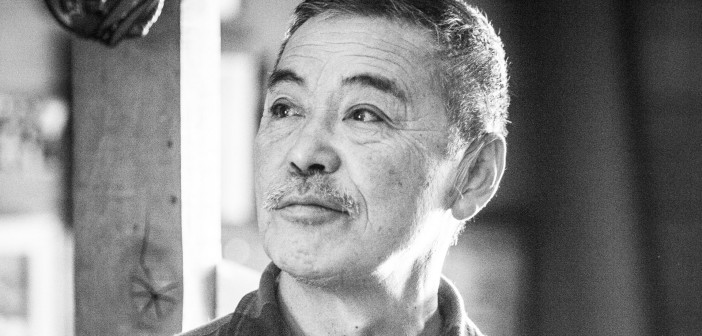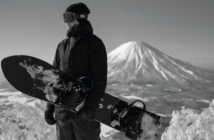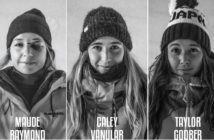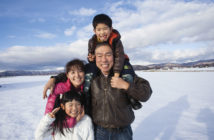“Earnestly address the present problem that is facing you and it will eventually lead to, not only yours, but many other people’s happiness.”
These are the words of his Holiness the 14th Dalai Lama, the spiritual leader of Tibet. I learnt this precept with Tibetan refugees while I was in the Nepalese Himalayas in 1969. Soon afterwards, when I moved to Niseko and became involved in Avalanche Accident Prevention in the area, I kept these words close to heart.
Avalanches are natural occurrences in snowy mountains, but they become an issue when people are involved.
Accidents started to happen on a regular basis in the 80’s. The direct reason was because the chairlifts were extended higher towards the peak, making it easier for anyone to access the out-of-bounds areas. Niseko is not a difficult mountain, but, as Heinrich’s law proves: the more people on the mountain, the more accidents will naturally occur. After a long debate on how accidents could be reduced while still protecting rider freedom to explore, the Niseko Rules were introduced.
The Rules advocate the prohibition of crossing boundary ropes, but the allowance to access out-of-bounds areas through the gates when they’re open.
“To not duck ropes, to not step out of bounds when gates are closed and to not enter the strictly off-limits areas at all times”, these were the main scheme of the Rules.
Corky Ward, the former head of ski patrol at Jackson Hole Mountain Resort, once told me that out-of-bounds riding was also prohibited in Jackson Hole in the past. However, poachers never stopped and conflicts between them and ski patrol persisted for over 20 years. Eventually, Corky made a decision to take a step forward and find a way to respect people’s will and freedom to ride while doing his best to prevent accidents, and finally managed to open the out-of-bounds areas there.
When Corky came to visit us 10 years ago, he was surprised to see that a similar situation had developed in Niseko and that our solution closely matched the one he had used for the past 20 years.
When he asked me about the compensation I receive he seemed very surprised by my response, however I approach avalanche accident prevention as my lifework, and as a part of this community I have been trying to follow the Dalai Lama’s ethic in solving a problem, without being overly concerned with remuneration.
Many people, both local and foreign, have been critical of Niseko’s approach to avalanche safety – considering it too restrictive. Some are of the opinion that we should adopt methods from the Canadian Avalanche Association (CAA) which is considered the world standard.
After 40 years in Niseko I simply don’t believe that adopting the North American standard for local conditions is sufficient. Many avalanche victims in the region have had textbook knowledge of the CAA but were still unprepared for the unique conditions of the Niseko area.
Niseko’s approach to avalanche prevention differs to North America’s; it’s based on the fact that many accidents which occur here happen during storms and high-winds.
The rapidly growing snowdrifts that develop under strong winds are extremely unstable and easily collapse with the slightest stimulation, leading to a large, high-consequence surface slab avalanche. The gates in Niseko close when such conditions are predicted. As long as the conditions are correctly evaluated day-by-day, accidents can mostly be avoided by preventing people from accessing dangerous areas on dangerous days.
Controlling gate access and notifying of the dangers on that given day is the method we have been using to maintain safety in the region.
A group of Swiss avalanche academics, along with Japanese researchers, are planning to come to Niseko this season to discuss the Niseko avalanche prediction system. Awareness is growing on the importance of how vulnerable wind-affected snowdrifts are – our Niseko Avalanche Information website is receiving over 5000 hits a day and there is growing attention from guides and researchers located in north-west USA and Alaska.
Whenever the gates open, hundreds of people enjoy backcountry access from the Hirafu and Annupuri gates, and it seems most people obey the rules when the gates are closed. As a result, the number of accidents in the area has diminished considerably, however, rare cases of small groups pushing backcountry touring in the surrounding mountains during poor weather and running into trouble seems to be on the rise.
My priority in Niseko has always been to maintain safety and I encourage all of Niseko’s Tour Operators, Accommodations, Guides and Media to spread awareness of the Niseko Rules for the benefit of their guests safety.
Always remember to never underestimate the power of an avalanche and to never overestimate the capability of your equipment or skills.
Akio Shinya
Niseko Avalanche Institute
World Ski Awards: Outstanding Contribution to Ski Tourism 2014
Further Reading




